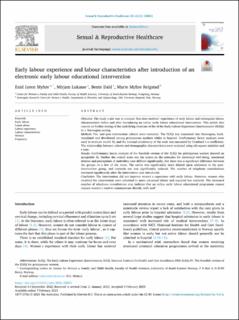| dc.contributor.author | Myhre, Enid | |
| dc.contributor.author | Lukasse, Mirjam | |
| dc.contributor.author | Dahl, Bente | |
| dc.contributor.author | Reigstad, Marte Myhre | |
| dc.date.accessioned | 2023-02-27T07:18:44Z | |
| dc.date.available | 2023-02-27T07:18:44Z | |
| dc.date.created | 2023-02-24T14:34:07Z | |
| dc.date.issued | 2023 | |
| dc.identifier.citation | Sexual & Reproductive HealthCare. 2023, 35 1-8. | en_US |
| dc.identifier.issn | 1877-5756 | |
| dc.identifier.uri | https://hdl.handle.net/11250/3054028 | |
| dc.description.abstract | Objective
The study’s aim was to compare first-time mothers’ experience of early labour and subsequent labour characteristics before and after introducing an online early labour educational intervention. This article also reports on further testing of the underlying structure of the of the Early Labour Experience Questionnaire (ELEQ) in a Norwegian setting.
Methods
Pre- and post-intervention cohorts were recruited. The ELEQ was translated into Norwegian, back-translated and distributed among primiparous mothers whilst in hospital. Confirmatory factor analyses were used to evaluate model fit, and the internal consistency of the scale was measured by Cronbach’s α coefficient. The relationship between cohorts and demographic characteristics were analysed using chi-square statistics and t-tests.
Results
Confirmatory factor analysis of the Swedish version of the ELEQ for primiparous women showed an acceptable fit. Neither the overall score nor the scores on the subscales for emotional well-being, emotional distress and perceptions of midwifery care differed significantly, but there was a significant difference between the groups on a few of the items. The cervix was significantly more dilated upon admission in the post-intervention group, and oxytocin use was significantly reduced. The number of telephone consultations increased significantly after the intervention was introduced.
Conclusion
The intervention did not improve women’s experience with early labour. However, women who received the intervention were admitted in more advanced labour and required less oxytocin. The increased number of telephone consultations may indicate that an online early labour educational programme cannot replace women’s need to communicate directly with staff. | en_US |
| dc.language.iso | eng | en_US |
| dc.publisher | Elsevier Ltd. | en_US |
| dc.rights | Navngivelse 4.0 Internasjonal | * |
| dc.rights.uri | http://creativecommons.org/licenses/by/4.0/deed.no | * |
| dc.title | Early labour experience and labour characteristics after introduction of an electronic early labour educational intervention | en_US |
| dc.title.alternative | Early labour experience and labour characteristics after introduction of an electronic early labour educational intervention | en_US |
| dc.type | Peer reviewed | en_US |
| dc.type | Journal article | en_US |
| dc.description.version | publishedVersion | en_US |
| dc.source.pagenumber | 1-8 | en_US |
| dc.source.volume | 35 | en_US |
| dc.source.journal | Sexual & Reproductive HealthCare | en_US |
| dc.identifier.doi | https://doi.org/10.1016/j.srhc.2023.100821 | |
| dc.identifier.cristin | 2129050 | |
| cristin.ispublished | true | |
| cristin.fulltext | original | |
| cristin.qualitycode | 1 | |

